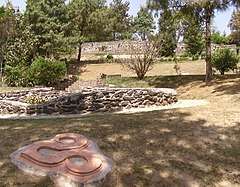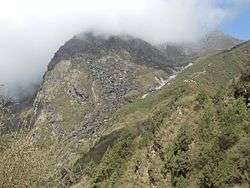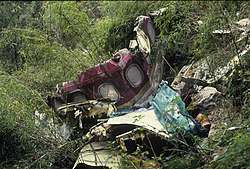Thai Airways International Flight 311
Thai Airways International Flight 311 was a flight from Bangkok, Thailand's Don Mueang International Airport to Kathmandu, Nepal's Tribhuvan International Airport. On Friday, 31 July 1992, an A310-304 on the route, registration HS-TID, crashed on approach to Kathmandu. At 07:00:26 UTC (12:45:26 NST; 14:00:26 ICT), the aircraft crashed into the side of a mountain 37 kilometres north of Kathmandu at an altitude of 11,500 feet (3,505 m) and a ground speed of 300 knots (560 km/h; 350 mph), killing all 99 passengers and 14 crew members on board. This was both the first hull loss and the first fatal accident involving the Airbus A310.[1][2]
 HS-TID, the aircraft involved in the accident seen at Don Mueang International Airport in April 1992 | |
| Accident | |
|---|---|
| Date | 31 July 1992 |
| Summary | Loss of situation awareness leading to controlled flight into terrain |
| Site | Langtang National Park, Langtang, Nepal 28°03′09″N 85°27′03″E |
| Aircraft | |
| Aircraft type | Airbus A310-304 |
| Aircraft name | Buri Ram |
| Operator | Thai Airways International |
| IATA flight No. | TG311 |
| ICAO flight No. | THA311 |
| Call sign | THAI 311 |
| Registration | HS-TID |
| Flight origin | Don Mueang International Airport, Bangkok, Thailand |
| Destination | Tribhuvan International Airport, Kathmandu, Nepal |
| Occupants | 113 |
| Passengers | 99 |
| Crew | 14 |
| Fatalities | 113 |
| Survivors | 0 |
Aircraft and crew
The aircraft's first flight was on 2 October 1987, and it entered service with Canadian airline Wardair under the registration C-FGWD. Wardair was acquired by Canadian Airlines International in 1989 and their operations consolidated and integrated under the Canadian Airlines banner. This Airbus A310-304 formally entered service with Canadian Airlines from 15 January 1990 (with the same registration). It was shortly thereafter sold to Thai Airways International, who took delivery on 9 May 1990 and had it re-registered as HS-TID.[1] The aircraft was powered by two General Electric CF6-80C2A2 turbofan engines.[3][4]
At the time of its destruction on 31 July 1992, the aircraft had been in commercial operations for less than five years.[1] It was piloted by Captain Preeda Suttimai (aged 41) and First Officer Phunthat Boonyayej (aged 52) with a cabin crew of 12 flight attendants looking after its 99 passengers.
Accident
Flight 311 departed Bangkok at 10:30 local time. It was scheduled to arrive in Kathmandu at 12:55 Nepal Standard Time.[5] After crossing into Nepalese airspace the pilots contacted air traffic control (ATC) and were cleared for an instrument approach from the south called the "Sierra VOR Circling Approach" for Runway 20. Nepalese ATC at the time was not equipped with radar.[6]
Shortly after reporting the Sierra fix 16 kilometres (10 mi) south of the Kathmandu VOR, the aircraft called ATC asking for a diversion to Calcutta, India because of a "technical problem".[7] Before ATC could reply, the flight rescinded their previous transmission. The flight was then cleared for a straight-in Sierra approach to Runway 02 and told to report leaving 9,500 feet (2,896 m). The captain asked numerous times for the winds and visibility at the airport, but ATC merely told him that Runway 02 was available.

A number of frustrating and misleading communications (due partly to language problems and partly to the inexperience of the air traffic controller, who was a trainee with only nine months on the job) ensued between air traffic control and the pilots regarding Flight 311's altitude and distance from the airport. The captain asked four times for permission to turn left, but after receiving no firm reply to his requests he announced that he was turning right and climbed the aircraft to flight level 200. The controller handling Flight 311 assumed from the flight's transmissions that the aircraft had called off the approach and was turning to the south, and he therefore cleared the aircraft to 11,500 feet (3,505 m), an altitude that would have been safe in the area south of the airport. The flight descended back to 11,500 feet, went through a 360-degree turn, and passed over the airport northbound.
Seconds before impact, the ground proximity warning system (GPWS) activated, and sounded alarms warning the crew of the imminent collision with the mountains. First officer Boonyayej warned captain Suttimai and urged him to turn the aircraft around, but due to his frustration from the communications with ATC, Suttimai erroneously stated the GPWS was just giving false reports. The aircraft crashed into a steep rock face in a remote area of the Langtang National Park at an altitude of 11,500 feet (3,505 m), killing all 113 people on board.
Investigation



Investigators from the Nepalese aviation authority, Airbus Industrie, and the Transportation Safety Board of Canada (which assisted with technical details) determined that the aircraft had experienced a minor fault in the workings of the inboard trailing flaps just after the aircraft reached the Sierra reporting fix. Concerned that the complex approach into Kathmandu in instrument conditions would be difficult with malfunctioning flaps and frustrated by ATC and his first officer's inconclusive and weak answers to his questions, the captain decided to divert to Calcutta.[8] The flaps suddenly began to work properly, but the captain was forced to resolve more aspects of the difficult approach himself due to his first officer's lack of initiative. Only after numerous extremely frustrating exchanges with ATC was the captain able to obtain adequate weather information for the airport, but by that time he had overflown Kathmandu and the aircraft was headed towards the Himalayas.[8]
Nepalese authorities found that the probable causes of the accident were the captain's and air traffic controller's loss of situational awareness; language and technical problems caused the captain to experience frustration and a high workload;[8] the first officer's lack of initiative and inconclusive answers to the captain's questions; the air traffic controller's inexperience, poor grasp of English, and reluctance to interfere with what he saw as piloting matters such as terrain separation; poor supervision of the inexperienced air traffic controller; Thai Airways International's failure to provide simulator training for the complex Kathmandu approach to its pilots; and improper use of the aircraft's flight management system.[6]
Victims
| Nationality | Passengers | Crew | Total |
|---|---|---|---|
| Australia | 1 | - | 1 |
| Belgium | 5 | - | 5 |
| Canada | 2 | - | 2 |
| Finland | 5 | - | 5 |
| Germany | 4 | - | 4 |
| Israel | 2 | - | 2 |
| Japan | 17 | - | 17 |
| Nepal | 23 | - | 23 |
| New Zealand | 1 | - | 1 |
| South Korea | 2 | - | 2 |
| Spain | 3 | - | 3 |
| Thailand | 21 | 14 | 35 |
| United Kingdom | 2 | - | 2 |
| United States | 11 | - | 11 |
| Total | 99 | 14 | 113[9] |
Aftermath
Thai Airways retired the flight number 311 after the accident along with its counterpart flight number 312, which had been used for the outbound flight from Kathmandu to Bangkok. These were replaced by flight numbers 319 and 320, respectively. These redesignated flights continued to be operated by Airbus A310 aircraft until this type was retired by the airline and replaced with Boeing 777 aircraft in 2001. The remains of the aircraft can still be seen in Langtang National Park on the trek from Ghopte to the Tharepati Pass.
Dramatization
The crash is featured in the tenth episode of the 17th season of Mayday (Air Crash Investigation). The episode is titled "The Lost Plane".
See also
References
- Ranter, Harro. "Accident Description". aviation-safety.net. Aviation Safety Network. Retrieved 15 May 2016.
- "KOIRALA v. THAI AIRWAYS INTERNATIONAL LTD". FindLaw. Retrieved 15 May 2016.
- "Thai Airways HS-TID (Airbus A310 - MSN 438) (Ex C-FGWD ) | Airfleets aviation". www.airfleets.net. Airfleets aviation. Retrieved 31 May 2019.
- "HS-TID Thai Airways International Airbus A310-300". www.planespotters.net. Retrieved 31 May 2019.
- "Thai Airliner Crashes In Nepal's Himalayan Foothills; 113 Aboard -- 11 Americans Are Listed As Among The Passengers". Seattle Times. AP. 31 July 1992. Retrieved 15 May 2016.
- Learmount, David (9 June 1993). "Confusion caused Kathmandu A310 crash" (PDF). Flight Global. Retrieved 15 May 2016.
- Special to The New York Times (2 August 1992). "Rescue Teams Fail to Find Thai Jet That Crashed With 113 Aboard". The New York Times. NYTimes Co.
- Hoang, Vicki (1996). "Cultural Factors in Aviation Incidents and Accidents: Thai Airways International Flight TG-311 — Kathmandu, Nepal". Cockpit-Cabin Communication: The Impact of National and Occupational Cultures (Master's thesis). San Jose, CA: San Jose State University. pp. 11–13. Document No.1382581.
- "113 Feared Dead in Nepal Crash; Thai jetliner slams into Himalayan hillside during heavy monsoon rains". Los Angeles Times. Associated Press. 1 August 1992.
External links

- Google Books description: "Thai Airways International Ltd. Airbus Industrie A310-304, HS-TID, Near Kathmandu, Nepal, 23NM NNE, 31 July 1992." Commission for the Accident Investigation of TG311, 1993.
- "Conclusions from report on CFIT accident near Kathmandu" (DjVu). ICAO Journal. Montreal: International Civil Aviation Organization. 48 (7): 23–26. September 1993. ISSN 0018-8778. Retrieved 2 May 2014.
- Pre-crash photos of HS-TID from Airliners.net